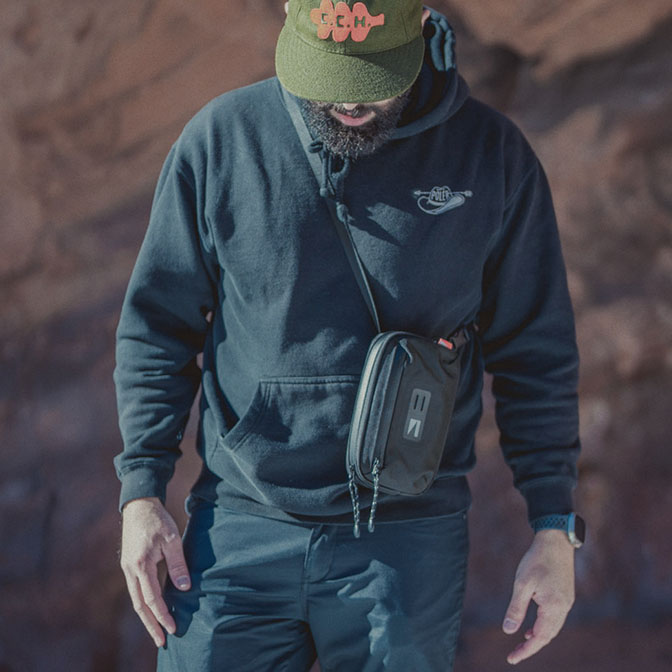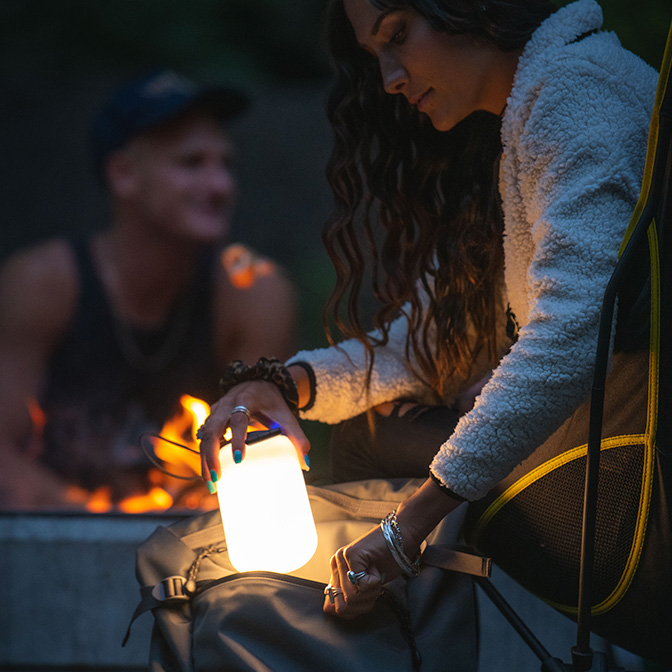Cascade 10000mAh Power Bank Charging Times
Posted On: Wed Dec 22 07:00:00 GMT 2021
The Cascade portable power bank is a problem-solver for all kinds of situations where your tech devices may run out of juice. Traveling makes everything less predictable. Remote and shared workspaces may not always have a power outlet nearby. Even people who charge their phones overnight may need a midday pickup.
To get the most out of your Cascade and prepare for any situation, it's important to know what you can expect. Keep reading for all the technical details, but here are the output charging levels for an iPhone 13 mini with a 2,406 mAh battery using the Cascade 10000mAh power bank for 30 minutes.
60% in 30 minutes (USB-C to Lightning Cable Recharge)
50% in 30 minutes (USB-A to Lightning Cable Recharge)
22% in 30 minutes (USB-A to Lightning Cable Pass-Through Recharge)
19% in 30 minutes (Qi Wireless Recharge)
USB Charging Times (Output)
We’ve heard that any iPhone can be charged to about 50% in 30 minutes when using a high-quality power bank, but we decided to put Cascade to the test. To get the absolute best charging times, pair Cascade with a USB-C to Lightning cable compared to a USB-A to Lightning cable.
Here are the USB charging times for an iPhone 13 mini using our USB-A to Lightning Cable:
• 40% in 25 minutes
• 50% in 30 minutes
• 63% in 40 minutes
• 72% in 50 minutes
• 80% in 60 minutes
• 86% in 70 minutes
• 92% in 80 minutes
• 96% in 90 minutes
• 100% in 100 minutes
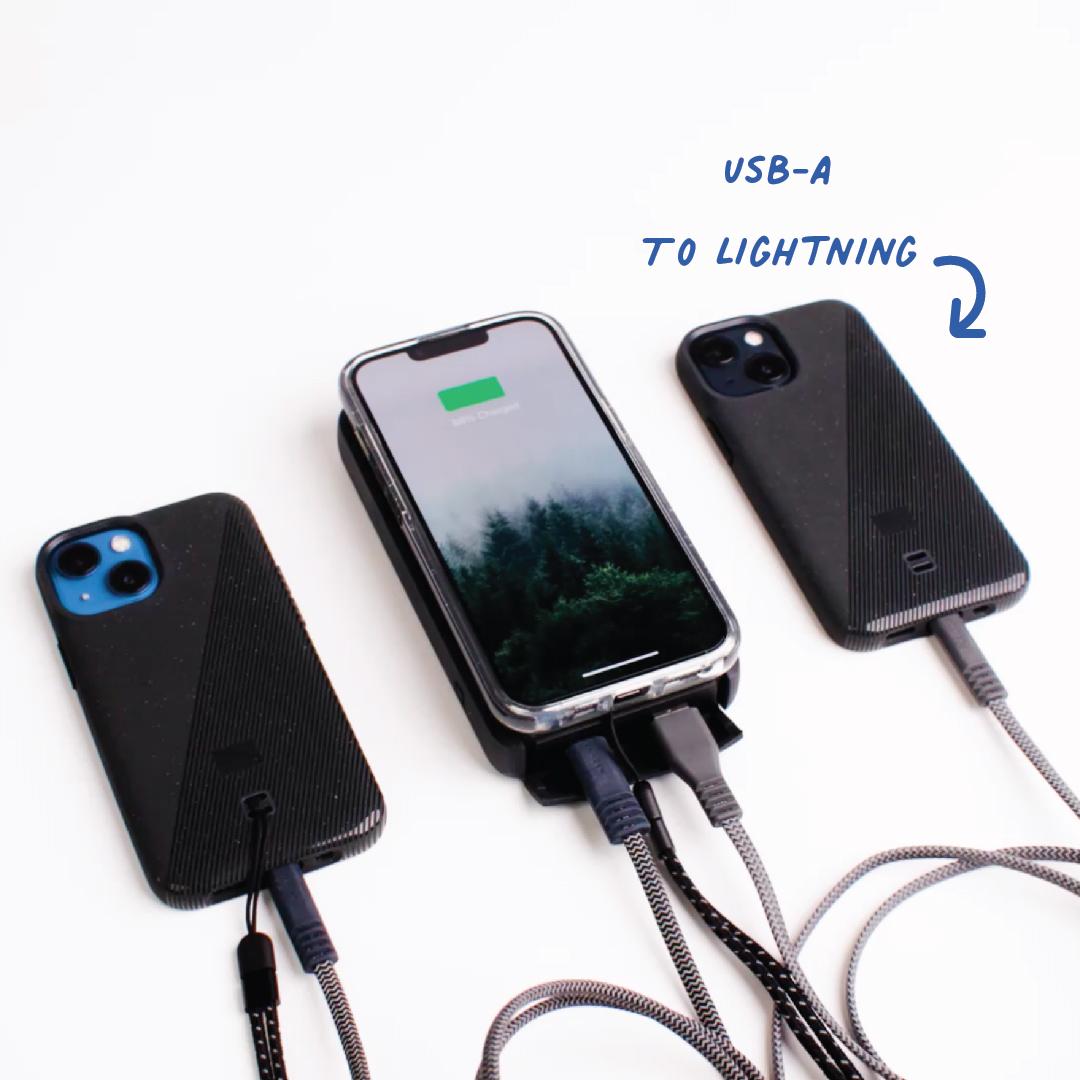
Here are the USB charging times for an iPhone 13 mini using our USB-C to Lightning Cable.
• 50% in 25 minutes
• 60% in 30 minutes
• 75% in 40 minutes
• 80% in 45 minutes
• 83% in 50 minutes
• 90% in 60 minutes
• 95% in 70 minutes
• 96% in 90 minutes
• 100% in 88 minutes
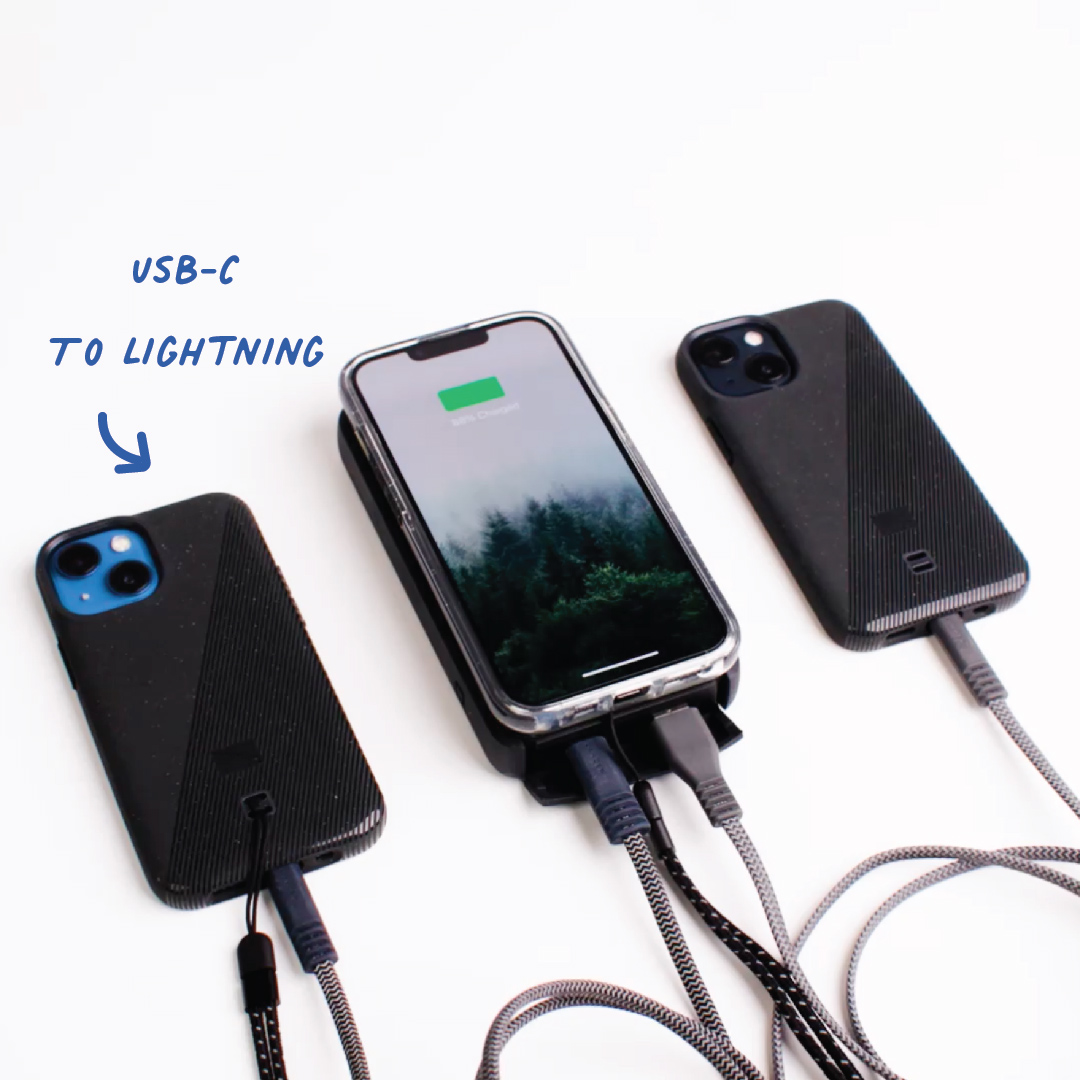
Pro Tips for Getting a Faster Charge:
Close your apps. As long as push notifications are enabled, apps don’t need to be open to monitor new messages. Better yet—don’t need to monitor messages at all? Get an even faster charge by putting your phone on airplane mode! We didn’t do this for our charging time tests because we know most people need to stay connected. Wondering why you get so much charge from the first 30 minutes? Fast charging works in two phases in which mostly empty batteries can absorb charge quickly before starting to taper off.
Qi Wireless Charging Times (Output)
In many ways, wireless charging is more about convenience than speed. Cascade’s 5W Qi wireless charging can recharge your phone in about the same time as a Marvel superhero movie, but you won’t need to wait to start the movie while looking for a charging cable. Simply slide your phone under the fastening band to begin charging, while still being able to use your phone. This means no more choosing between the best spot on the couch and being within reach of your phone while it’s charging.
Here are the charging times for an iPhone 13 mini using the Cascade Qi wireless charging feature:
• 10% in 15 minutes
• 16% in 25 minutes
• 19% in 30 minutes
• 24% in 40 minutes
• 29% in 50 minutes
• 35% in 60 minutes
• 53% in 90 minutes
• 68% in 120 minutes
• 81% in 150 minutes
• 90% in 180 minutes
• 100% in 210 minutes
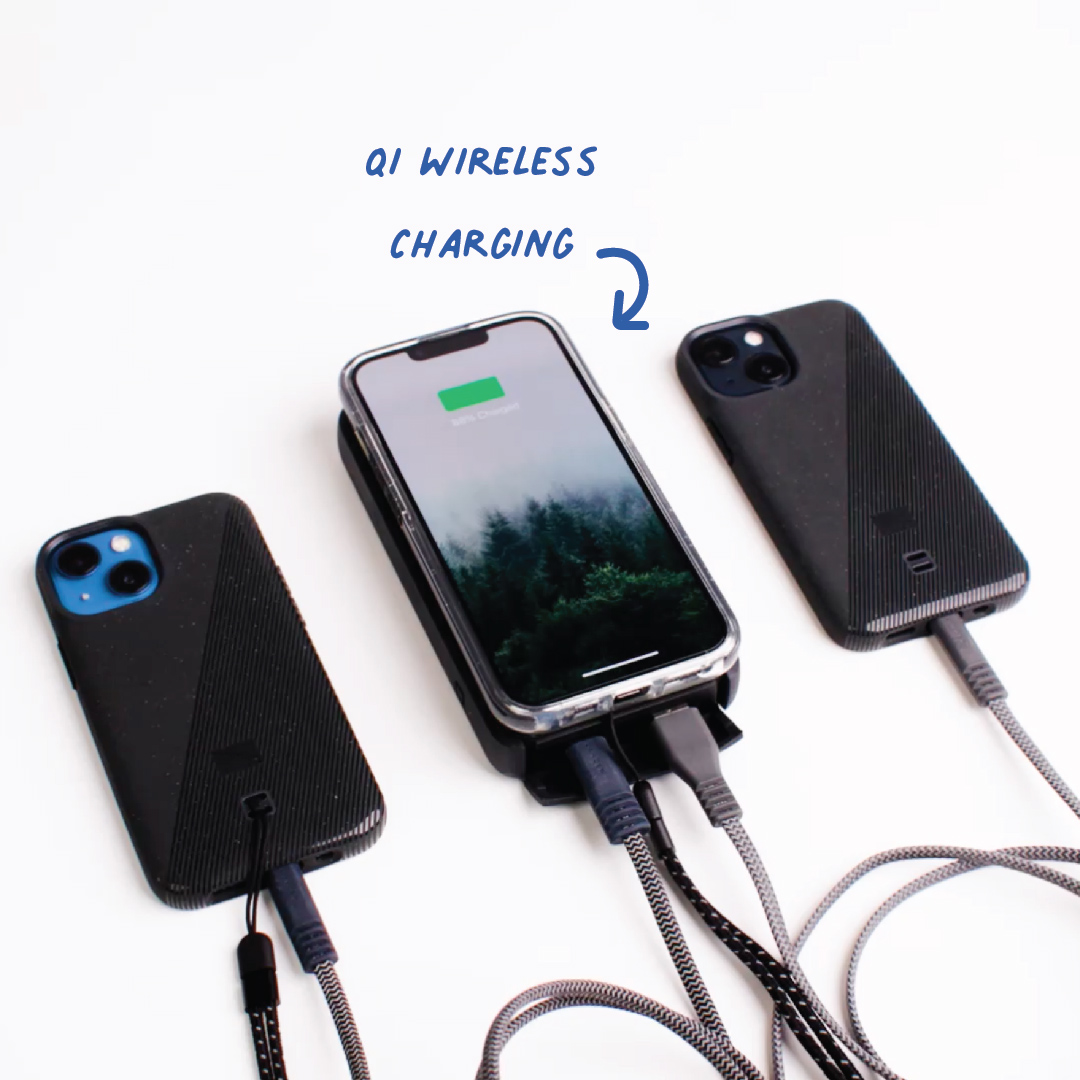
Pro Tips for Qi Wireless Charging:
The same tips about closing apps and using airplane mode apply to wireless charging, but there’s a little more to the story. Certain types of materials can slow down wireless charging times if placed between the charger and the device. Be sure that your phone case—like all Lander cases—are compatible with Qi wireless charging. There are faster wireless chargers on the market, but they carry a heavier price tag and a heavier carbon footprint by converting more of their power into heat than deliverable charge.
Fast USB Charging Times (Input)
It’s one thing for your phone and other devices to run out of juice when you know they can be plugged in and charging at a moment’s notice. But when the Cascade itself starts to run low, it’s important to know how long it will take to get the power bank itself back to full charge.
Here are the input USB charging times for the Cascade 10000mAh power bank:
• Using an 18W Power Delivery (PD)
charger with our included USB-A to USB-C Cable: ~3.5 hrs
• Using an 18W PD charger with a USB-C to USB-C Cable: ~3 hrs
Here are the input charging times for the smaller Cascade 6000mAh power bank:
• Using an 18W PD charger with our
included USB-A to USB-C Cable: ~2.5 hrs
• Using an 18W PD charger with a USB-C to USB-C Cable: ~2 hrs
Pro Tips for Recharging a Power Bank
By far, the most important factors here are a wall charger with an 18W or higher charge rating, as well as a high-quality charging cable, such as our Neve charging cables. If the wall charger, cable, or Cascade have seen several years of heavy use, you may also experience slower charging times. Check out our pass-through charging times below, and you’ll also know what to expect when charging your Cascade and phone at the same time.
Pass-Through Charging Times
Your phone is at 10% charge, and you forgot to plug in your power bank for two days straight. Sound familiar? With Cascade, you can plug your phone into the power bank while the power bank is plugged into a wall outlet. Pass-through charging can be a life-saver in these types of situations, but it does come at a cost. Both input and output charging are slightly less efficient, as more of the power is converted into heat. Cascade is designed to prioritize charging your device, before fully recharging the power bank itself.
Here is what you can expect from pass-through charging times when using a 30W PD charger with a USB-C to Lightning cable for Cascade and a USB-C to USB-C cable between Cascade and an iPhone 13 mini:
• 9% in 10 minutes & 1/5 LEDs
• 16% in 20 minutes & 1/5 LEDs
• 22% in 30 minutes & 1/5 LEDs
• 29% in 40 minutes & 1/5 LEDs
• 37% in 50 minutes & 1/5 LEDs
• 44% in 60 minutes & 1/5 LEDs
• 65% in 90 minutes & 1/5 LEDs
• 85% in 120 minutes & 1/5 LEDs
• 98% in 150 minutes & 1/5 LEDs
• 100% in 160 minutes & 1/5 LEDs
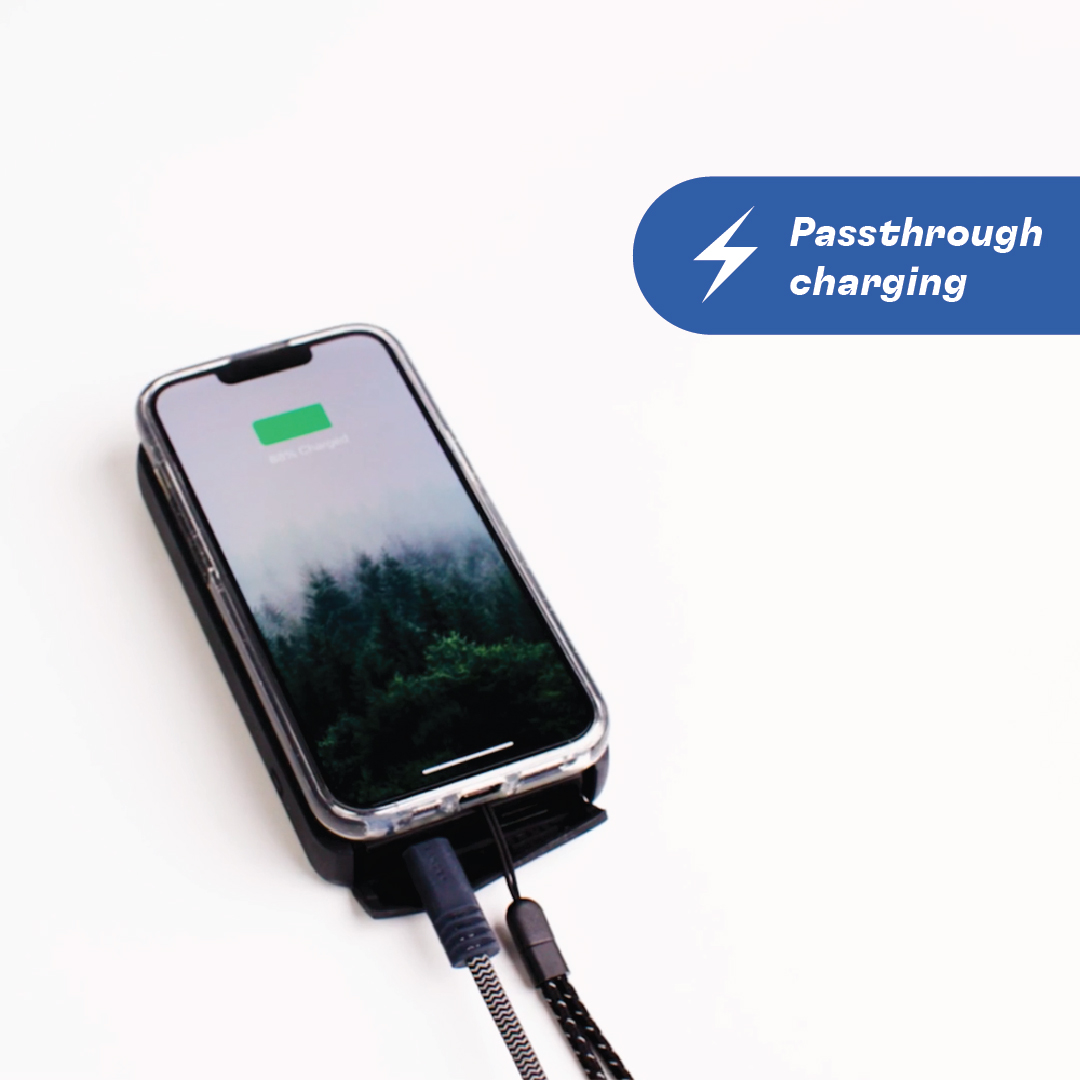
* It may take up to an additional 3 hours to fully recharge the Cascade.
Pro Tips for Pass Through-Charging:
Cascade is going to help you in all kinds of situations where you need to charge your devices. We don’t need to push solutions that are less than optimal, so we recommend that you avoid pass-through charging when possible. This will reduce residual heat and inefficiency. If you have the right charging cables, power adapters, and multiple wall outlets, charge both devices independently. The only true ideal scenario for pass-through charging is when you only have one available outlet or power adaptor.
Off-Label Charging for Larger Devices
What about charging larger devices that aren’t properly rated for 23W cable charging? You can use Cascade to power most tablet devices, but we don’t usually recommend it for most laptops. Because the laptop will drain faster than the Cascade can deliver a charge, the best you can hope for is that plugging in the Cascade will slow the drain of that final 10% of power.
Fast Charging Times vs. Long-Term Battery Performance
There are lots of outdated beliefs about how charging habits impact long-term battery performance, especially for smartphones. It’s a myth, for example, that fast charging will hurt your battery. Instead, the biggest threat is heat. Most smartphones as well as the Cascade itself will shut off as a safety precaution against excessive heat.
In terms of daily charging habits, the best thing you can do is to avoid constantly keeping your phone charged or letting it run completely dry. All batteries suffer some degradation over time, but if you’re concerned about the long-term performance of your batteries, try to keep the device charged between 20-80% most of the time. With our Cascade portable power bank at your side, you can rest assured that there’s no need for a full charge at all times.

The Cascade portable power bank is a problem-solver for all kinds of situations where your tech devices may run out of juice. Traveling makes everything less predictable. Remote and shared workspaces may not always have a power outlet nearby. Even people who charge their phones overnight may need a midday pickup.
To get the most out of your Cascade and prepare for any situation, it's important to know what you can expect. Keep reading for all the technical details, but here are the output charging levels for an iPhone 13 mini with a 2,406 mAh battery using the Cascade 10000mAh power bank for 30 minutes.
60% in 30 minutes (USB-C to Lightning Cable Recharge)
50% in 30 minutes (USB-A to Lightning Cable Recharge)
22% in 30 minutes (USB-A to Lightning Cable Pass-Through Recharge)
19% in 30 minutes (Qi Wireless Recharge)
USB Charging Times (Output)
We’ve heard that any iPhone can be charged to about 50% in 30 minutes when using a high-quality power bank, but we decided to put Cascade to the test. To get the absolute best charging times, pair Cascade with a USB-C to Lightning cable compared to a USB-A to Lightning cable.
Here are the USB charging times for an iPhone 13 mini using our USB-A to Lightning Cable:
• 40% in 25 minutes
• 50% in 30 minutes
• 63% in 40 minutes
• 72% in 50 minutes
• 80% in 60 minutes
• 86% in 70 minutes
• 92% in 80 minutes
• 96% in 90 minutes
• 100% in 100 minutes

Here are the USB charging times for an iPhone 13 mini using our USB-C to Lightning Cable.
• 50% in 25 minutes
• 60% in 30 minutes
• 75% in 40 minutes
• 80% in 45 minutes
• 83% in 50 minutes
• 90% in 60 minutes
• 95% in 70 minutes
• 96% in 90 minutes
• 100% in 88 minutes

Pro Tips for Getting a Faster Charge:
Close your apps. As long as push notifications are enabled, apps don’t need to be open to monitor new messages. Better yet—don’t need to monitor messages at all? Get an even faster charge by putting your phone on airplane mode! We didn’t do this for our charging time tests because we know most people need to stay connected. Wondering why you get so much charge from the first 30 minutes? Fast charging works in two phases in which mostly empty batteries can absorb charge quickly before starting to taper off.
Qi Wireless Charging Times (Output)
In many ways, wireless charging is more about convenience than speed. Cascade’s 5W Qi wireless charging can recharge your phone in about the same time as a Marvel superhero movie, but you won’t need to wait to start the movie while looking for a charging cable. Simply slide your phone under the fastening band to begin charging, while still being able to use your phone. This means no more choosing between the best spot on the couch and being within reach of your phone while it’s charging.
Here are the charging times for an iPhone 13 mini using the Cascade Qi wireless charging feature:
• 10% in 15 minutes
• 16% in 25 minutes
• 19% in 30 minutes
• 24% in 40 minutes
• 29% in 50 minutes
• 35% in 60 minutes
• 53% in 90 minutes
• 68% in 120 minutes
• 81% in 150 minutes
• 90% in 180 minutes
• 100% in 210 minutes

Pro Tips for Qi Wireless Charging:
The same tips about closing apps and using airplane mode apply to wireless charging, but there’s a little more to the story. Certain types of materials can slow down wireless charging times if placed between the charger and the device. Be sure that your phone case—like all Lander cases—are compatible with Qi wireless charging. There are faster wireless chargers on the market, but they carry a heavier price tag and a heavier carbon footprint by converting more of their power into heat than deliverable charge.
Fast USB Charging Times (Input)
It’s one thing for your phone and other devices to run out of juice when you know they can be plugged in and charging at a moment’s notice. But when the Cascade itself starts to run low, it’s important to know how long it will take to get the power bank itself back to full charge.
Here are the input USB charging times for the Cascade 10000mAh power bank:
• Using an 18W Power Delivery (PD)
charger with our included USB-A to USB-C Cable: ~3.5 hrs
• Using an 18W PD charger with a USB-C to USB-C Cable: ~3 hrs
Here are the input charging times for the smaller Cascade 6000mAh power bank:
• Using an 18W PD charger with our
included USB-A to USB-C Cable: ~2.5 hrs
• Using an 18W PD charger with a USB-C to USB-C Cable: ~2 hrs
Pro Tips for Recharging a Power Bank
By far, the most important factors here are a wall charger with an 18W or higher charge rating, as well as a high-quality charging cable, such as our Neve charging cables. If the wall charger, cable, or Cascade have seen several years of heavy use, you may also experience slower charging times. Check out our pass-through charging times below, and you’ll also know what to expect when charging your Cascade and phone at the same time.
Pass-Through Charging Times
Your phone is at 10% charge, and you forgot to plug in your power bank for two days straight. Sound familiar? With Cascade, you can plug your phone into the power bank while the power bank is plugged into a wall outlet. Pass-through charging can be a life-saver in these types of situations, but it does come at a cost. Both input and output charging are slightly less efficient, as more of the power is converted into heat. Cascade is designed to prioritize charging your device, before fully recharging the power bank itself.
Here is what you can expect from pass-through charging times when using a 30W PD charger with a USB-C to Lightning cable for Cascade and a USB-C to USB-C cable between Cascade and an iPhone 13 mini:
• 9% in 10 minutes & 1/5 LEDs
• 16% in 20 minutes & 1/5 LEDs
• 22% in 30 minutes & 1/5 LEDs
• 29% in 40 minutes & 1/5 LEDs
• 37% in 50 minutes & 1/5 LEDs
• 44% in 60 minutes & 1/5 LEDs
• 65% in 90 minutes & 1/5 LEDs
• 85% in 120 minutes & 1/5 LEDs
• 98% in 150 minutes & 1/5 LEDs
• 100% in 160 minutes & 1/5 LEDs
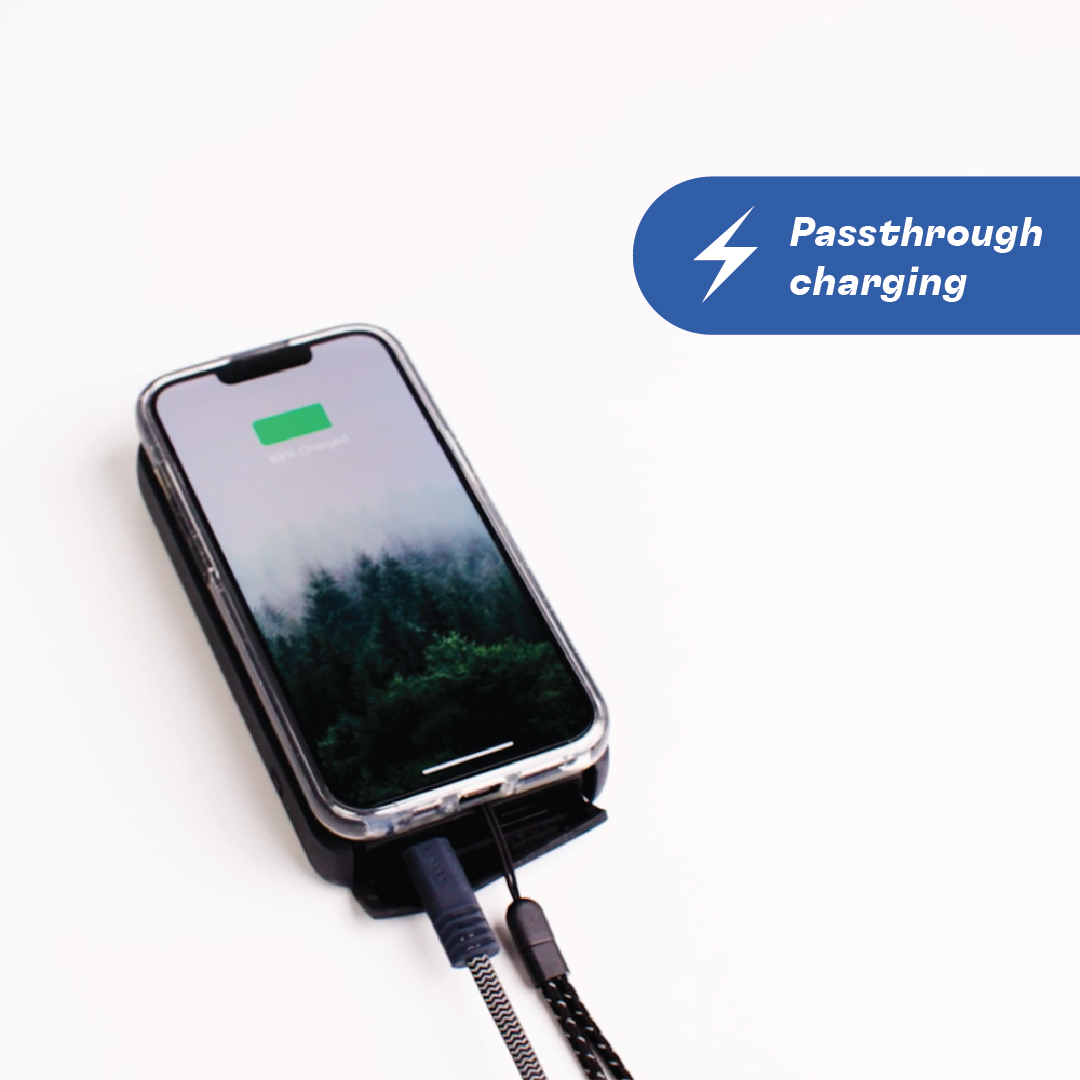
* It may take up to an additional 3 hours to fully recharge the Cascade.
Pro Tips for Pass Through-Charging:
Cascade is going to help you in all kinds of situations where you need to charge your devices. We don’t need to push solutions that are less than optimal, so we recommend that you avoid pass-through charging when possible. This will reduce residual heat and inefficiency. If you have the right charging cables, power adapters, and multiple wall outlets, charge both devices independently. The only true ideal scenario for pass-through charging is when you only have one available outlet or power adaptor.
Off-Label Charging for Larger Devices
What about charging larger devices that aren’t properly rated for 23W cable charging? You can use Cascade to power most tablet devices, but we don’t usually recommend it for most laptops. Because the laptop will drain faster than the Cascade can deliver a charge, the best you can hope for is that plugging in the Cascade will slow the drain of that final 10% of power.
Fast Charging Times vs. Long-Term Battery Performance
There are lots of outdated beliefs about how charging habits impact long-term battery performance, especially for smartphones. It’s a myth, for example, that fast charging will hurt your battery. Instead, the biggest threat is heat. Most smartphones as well as the Cascade itself will shut off as a safety precaution against excessive heat.
In terms of daily charging habits, the best thing you can do is to avoid constantly keeping your phone charged or letting it run completely dry. All batteries suffer some degradation over time, but if you’re concerned about the long-term performance of your batteries, try to keep the device charged between 20-80% most of the time. With our Cascade portable power bank at your side, you can rest assured that there’s no need for a full charge at all times.

